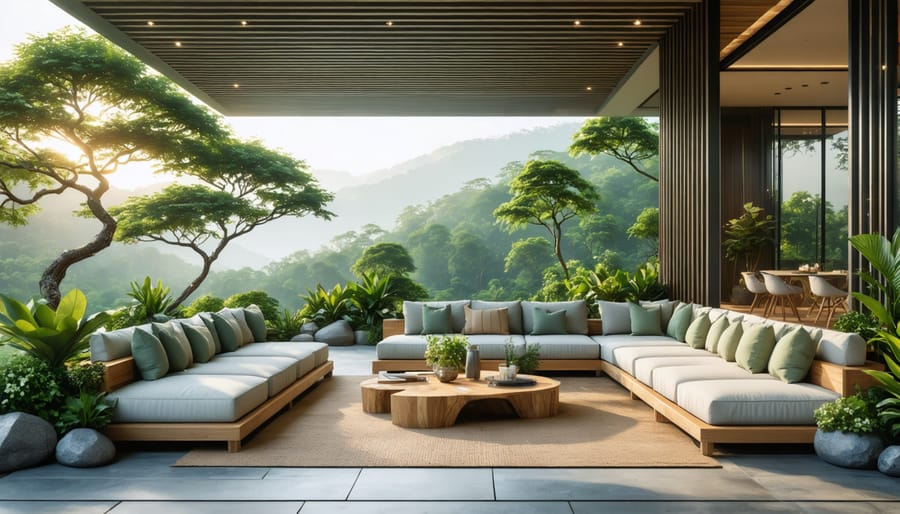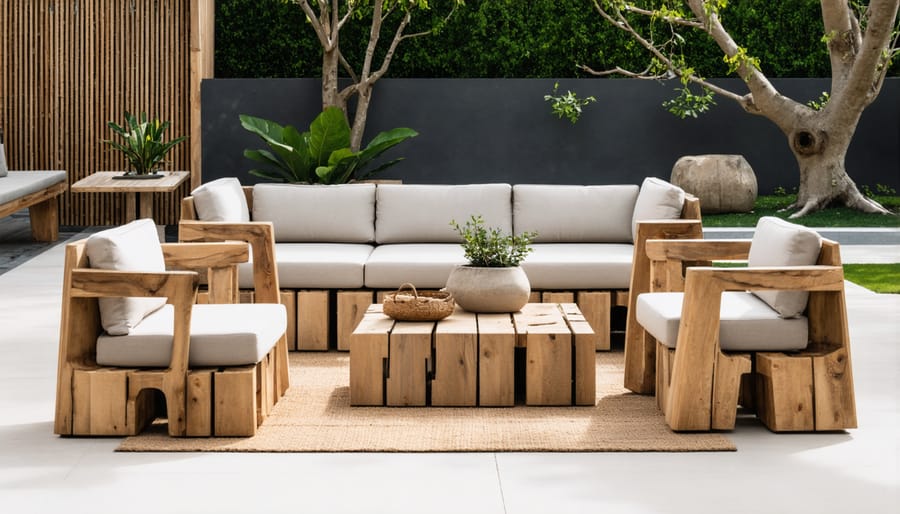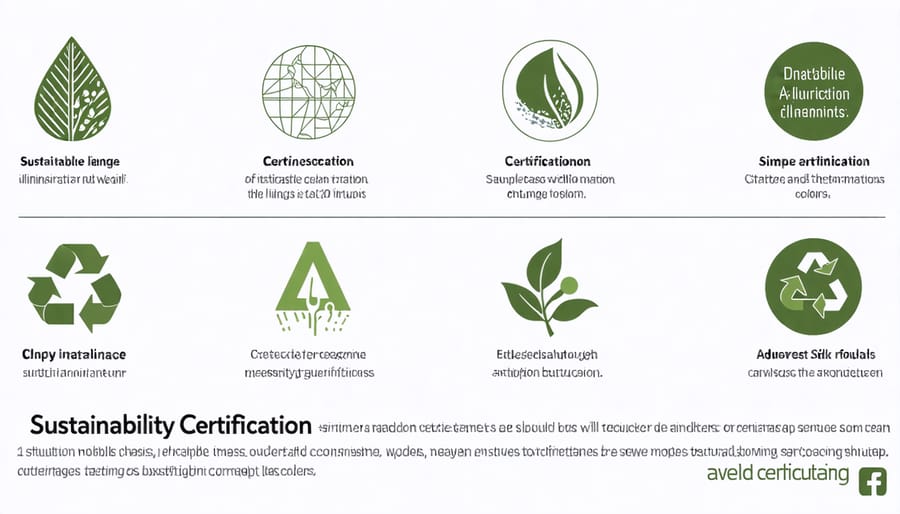
Beautiful Outdoor Living Spaces That Won’t Harm the Planet
Transform your outdoor living space into an eco-conscious sanctuary with sustainable furniture choices that protect both the environment and your investment. Today’s sustainable outdoor furniture combines sophisticated design with environmental responsibility, offering durability and style without compromising our planet’s future. From FSC-certified teak and recycled plastic to innovative bamboo composites, sustainable materials have revolutionized outdoor furnishing options, making it easier than ever to create beautiful, earth-friendly spaces that last for generations.
Modern homeowners increasingly recognize that choosing sustainable outdoor furniture isn’t just about environmental impact – it’s about superior quality, enhanced durability, and reduced maintenance needs. Whether you’re furnishing a compact urban balcony or designing an expansive backyard retreat, sustainable options now rival traditional materials in both aesthetics and performance while significantly reducing your carbon footprint.
This shift toward sustainability doesn’t mean sacrificing style or comfort. Leading manufacturers have mastered the art of creating weather-resistant, environmentally responsible pieces that complement any outdoor design scheme, from minimalist modern to classic traditional. By choosing sustainable outdoor furniture, you’re not just making a purchase – you’re making a statement about your commitment to environmental stewardship while investing in pieces that will stand the test of time.
Eco-Friendly Materials Revolutionizing Outdoor Furniture
Reclaimed and FSC-Certified Woods
When it comes to sustainable outdoor furniture, reclaimed and FSC-certified woods are among the most eco-friendly choices available. Reclaimed wood gives new life to existing materials, often sourced from old buildings, barns, or retired shipping materials. This not only prevents waste but also adds character through unique patinas and grain patterns that tell a story.
FSC (Forest Stewardship Council) certification ensures that wood comes from responsibly managed forests that provide environmental, social, and economic benefits. Look for the FSC label when shopping, as it guarantees your furniture hasn’t contributed to deforestation or habitat destruction.
Popular sustainable wood options include teak, acacia, and eucalyptus from certified sources. These species naturally resist weather damage and insects, making them perfect for outdoor use. Reclaimed cedar and pine also make excellent choices when properly treated and maintained.
Before purchasing, ask retailers about their wood sourcing practices and request documentation of FSC certification. Many manufacturers now proudly display their sustainability credentials, making it easier to make environmentally conscious decisions for your outdoor space.

Recycled Plastics and Metals
Recycled plastics and metals are revolutionizing the outdoor furniture industry, offering eco-friendly alternatives that don’t compromise on style or durability. High-density polyethylene (HDPE) from recycled milk jugs and water bottles is transformed into weather-resistant chairs, tables, and loungers that can withstand years of outdoor exposure. These pieces resist fading, cracking, and peeling while keeping thousands of plastic containers out of landfills.
Recycled aluminum and steel are equally impressive options, combining sustainability with strength. These metals can be recycled indefinitely without losing quality, making them perfect for long-lasting outdoor furniture. Look for pieces made from post-consumer metals, which require only a fraction of the energy needed to produce new materials.
Many manufacturers now offer furniture lines that blend both recycled plastics and metals, creating hybrid designs that maximize durability and minimize environmental impact. These pieces often come in various colors and styles, proving that sustainable choices don’t mean sacrificing aesthetic appeal. Plus, they’re typically low-maintenance and easy to clean, making them practical choices for busy homeowners.
Innovative Bio-Based Materials
The future of outdoor furniture is being revolutionized by innovative sustainable materials derived from natural sources. Bamboo composites offer exceptional durability while being rapidly renewable. Mycelium-based materials, created from mushroom roots, provide weather-resistant properties perfect for outdoor use. Cork-infused polymers deliver water-resistance and comfort while maintaining eco-friendly credentials. These bio-based alternatives not only reduce environmental impact but often outperform traditional materials in terms of weather resistance and longevity. Hemp-based composites are gaining popularity for their strength and natural resistance to UV damage, while recycled agricultural waste is being transformed into durable furniture components that stand up to outdoor conditions.
Durability Meets Sustainability
Weather-Resistant Features
Sustainable outdoor furniture must withstand nature’s elements while maintaining its eco-friendly credentials. Today’s weather-resistant features combine innovative materials with environmentally conscious design. Natural oils and waxes derived from sustainable sources provide excellent protection for wooden furniture, creating a water-resistant barrier without harmful chemicals. These treatments can be easily reapplied, extending furniture life while minimizing environmental impact.
For bamboo and rattan pieces, UV-resistant eco-polymers create a protective shield against sun damage and moisture. These natural-based coatings prevent cracking and fading while remaining biodegradable. Recycled plastics used in outdoor furniture often include UV stabilizers derived from mineral sources, ensuring longevity without compromising sustainability.
Many sustainable manufacturers now incorporate weather-resistant features directly into the material composition. For instance, naturally rot-resistant woods like reclaimed teak require minimal treatment while offering exceptional durability. Similarly, furniture made from recycled marine plastic includes inherent weather resistance, thanks to its original oceanic applications.
To maximize weather protection sustainably, look for designs with proper drainage channels, elevated feet, and breathable covers made from organic materials. These thoughtful features prevent water accumulation and mold growth while maintaining the furniture’s eco-friendly status.
Maintenance and Care
Proper maintenance is key to extending the life of your sustainable outdoor furniture, reducing the need for replacements and minimizing environmental impact. Start by regularly cleaning your pieces with eco-friendly soap and water, avoiding harsh chemical cleaners that can harm both your furniture and the environment. For wooden furniture, apply natural oils like linseed or tung oil twice a year to protect against moisture and UV damage.
Store cushions and fabric elements indoors during severe weather, and use breathable furniture covers made from sustainable materials when pieces aren’t in use. For metal components, address rust spots immediately with natural rust converters, and tighten loose screws or bolts promptly to prevent structural issues.
Consider seasonal deep cleaning using biodegradable products and natural solutions like vinegar and baking soda. Touch up scratches on wooden surfaces with eco-friendly sealants, and repair minor damage promptly to prevent larger issues. During winter months, store furniture in a covered area if possible, or elevate it off the ground to prevent moisture damage.
Regular maintenance not only preserves your furniture but also maintains its sustainable qualities, ensuring your eco-friendly investment lasts for years to come.
Style Without Compromise
Contemporary Eco-Designs
Today’s eco-conscious furniture designers are reimagining outdoor spaces with innovative sustainable solutions that don’t compromise on style. By following sustainable design principles, manufacturers are creating sleek, modern pieces that blend seamlessly with nature. Popular trends include modular seating made from recycled ocean plastics, featuring clean lines and contemporary silhouettes that can be easily reconfigured for different occasions.
Minimalist designs incorporating bamboo and reclaimed teak are making waves, often paired with weather-resistant fabrics made from recycled materials. Multi-functional pieces, such as storage benches and convertible tables, maximize space while reducing material waste. Living furniture, which integrates planters into seating and table designs, is gaining popularity among urban dwellers looking to create green sanctuaries in limited spaces.
Color palettes tend toward earth tones and natural finishes, though bold accents using eco-friendly dyes are emerging as statement pieces. These modern designs often incorporate smart features like solar-powered lighting or weather-resistant charging stations, proving that sustainability and technology can work hand in hand.

Color and Texture Options
Sustainable outdoor furniture offers an impressive range of colors and textures that rival traditional options while maintaining eco-friendly credentials. Natural wood finishes, from honey-toned teak to rich mahogany-colored eucalyptus, develop beautiful patinas over time. Recycled plastic materials come in vibrant hues that won’t fade, including earth tones, coastal blues, and modern grays that complement any outdoor space.
For texture enthusiasts, reclaimed wood furniture preserves the character of its original source, featuring unique grain patterns and natural imperfections that tell a story. Bamboo furniture can be finished to highlight its distinctive node patterns, while recycled metal pieces offer both smooth and textured options that resist weathering.
Contemporary sustainable materials like hemp-based composites and recycled maritime rope provide interesting tactile experiences while maintaining durability. Many manufacturers now offer customizable options, allowing you to choose from weather-resistant fabric covers in various patterns and colors, all made from recycled materials or organic textiles.
Making Smart Sustainable Choices
Certification Labels to Look For
When shopping for eco-friendly outdoor furniture, certain certification labels can help you make informed sustainable furniture choices. The FSC (Forest Stewardship Council) certification is one of the most respected marks, ensuring wood products come from responsibly managed forests. Look for the FSC logo with its tree-checkmark symbol on wooden furniture pieces.
For items containing recycled materials, the SCS Recycled Content certification validates the percentage of recycled components used. The GREENGUARD certification is crucial for pieces with cushions or synthetic materials, as it ensures low chemical emissions and better indoor air quality.
The Global Organic Textile Standard (GOTS) is important for outdoor cushions and fabric components, guaranteeing organic materials from cultivation through environmentally and socially responsible manufacturing. For metal furniture, look for the Cradle to Cradle certification, which evaluates products based on material health, material reuse, renewable energy use, water stewardship, and social fairness.
The BIFMA LEVEL certification specifically addresses furniture sustainability across multiple attributes, including materials, energy usage, human and ecosystem health, and social responsibility. When you spot these labels, you can be confident you’re making environmentally responsible choices for your outdoor space.

Cost Considerations
While sustainable outdoor furniture may have a higher upfront cost, the long-term value often outweighs the initial investment. Quality sustainable pieces typically last 10-15 years or more, compared to 3-5 years for conventional furniture, making them more cost-effective over time.
Consider that sustainable materials like teak, recycled plastic, and bamboo require minimal maintenance, saving both time and money on upkeep. These materials resist weather damage, reducing the need for frequent repairs or replacements. Many sustainable furniture manufacturers also offer warranties ranging from 5 to 20 years, providing additional value protection.
The resale value of sustainable outdoor furniture tends to be higher, especially for pieces made from premium materials like reclaimed wood or high-grade recycled materials. When calculating costs, factor in reduced maintenance expenses, longer lifespan, and potential energy savings from integrated smart features in modern sustainable furniture.
Some manufacturers offer financing options or seasonal sales, making sustainable choices more accessible. Additionally, many localities provide tax incentives for purchasing eco-friendly products, which can help offset the initial investment. For commercial properties, sustainable furniture choices may contribute to LEED certification points, potentially increasing property value.
Local vs. Global Sources
When choosing sustainable outdoor furniture, the distance between production and your home matters significantly. Local sourcing reduces transportation emissions and supports your community’s economy, while often providing better access to craftspeople who can repair or refurbish pieces. Many local artisans use reclaimed materials and traditional woodworking techniques, creating unique pieces that tell a story.
However, global sourcing can sometimes offer advantages in sustainability. Some regions specialize in specific sustainable materials, like bamboo from Southeast Asia or certified teak from managed forests. These locations often have generations of expertise in working with these materials sustainably. The key is to evaluate the entire supply chain, not just the distance traveled.
Consider a balanced approach: look for local options first, especially for materials abundant in your region, but don’t automatically rule out global sources if they offer truly sustainable practices and materials. Check for certification labels and ask about the company’s environmental policies. Some global manufacturers have invested in carbon-neutral shipping and use renewable energy in their production, potentially offsetting the environmental impact of transportation.
Making the switch to sustainable outdoor furniture isn’t just a trend – it’s a meaningful step toward protecting our environment while creating beautiful outdoor spaces. By choosing eco-friendly materials and responsible manufacturing processes, we’re reducing our carbon footprint and preserving natural resources for future generations. These sustainable choices often prove more durable and cost-effective in the long run, requiring less maintenance and replacement over time.
The benefits extend beyond environmental impact. Sustainable outdoor furniture often brings unique character and style to your space, with natural materials aging gracefully and developing distinctive patinas. Plus, you’ll have peace of mind knowing your outdoor oasis reflects your commitment to environmental stewardship.
As you plan your next outdoor furniture purchase, consider the lasting impact of your choices. Look for certified sustainable materials, research manufacturers’ environmental practices, and don’t hesitate to ask questions about production methods and material sourcing. Remember that every sustainable choice, no matter how small, contributes to a healthier planet.
Start your sustainable outdoor living journey today. Whether you’re furnishing a small balcony or a sprawling patio, choosing eco-friendly options helps create a more sustainable future while enhancing your outdoor living space. Your choice matters – make it count for both style and sustainability.
